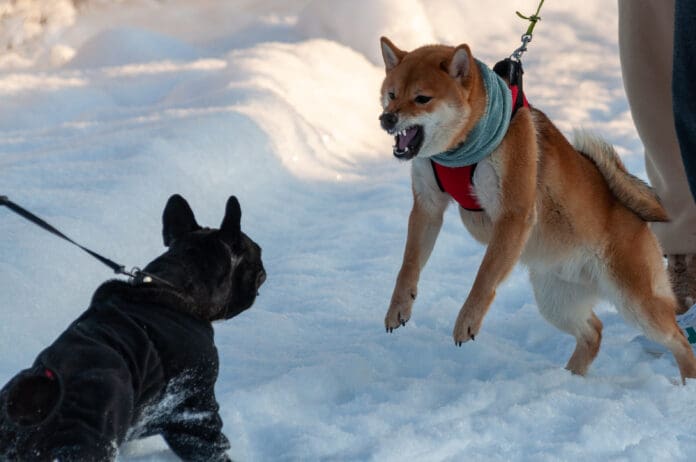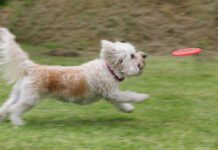Reactivity in dogs is an abnormal level of arousal in response to a normal stimulus. “Reactive” doesn’t necessarily imply aggression, although some dogs with reactive behaviors certainly can be aggressive. It just means a dog who gets way too excited over something in her environment—and not just excited as in, “Oh hi, I’m so happy to see you!” Rather, it’s way too excited as in an alarmingly aroused “Bark, bark, bark, lunge,” and maybe even a canine scream or two and possible escalation to biting.
Note that I use the phrase, “a dog with reactive behavior” rather than “reactive dog.” While a dog’s reactive behavior can be overwhelming to her human, it usually only occurs in specific trigger circumstances. Labeling your dog a “reactive dog” reduces her to her least favorable trait, when in fact most of the time she may be a lovely canine companion, especially if you do a good job of managing her exposure to her trigger stimuli.
What Causes a Dog to Display Reactive Behavior?
The most common causes of reactive behavior in dogs are:
- Excitement/Frustration. We often see this behavior with dogs who have a history of being able to perform a particular behavior and now are prevented from doing so.
The most common example is a dog who has been allowed to regularly greet other dogs at will, both on and off leash, and is now restricted by her leash or a fence. This is known as “leash-reactivity.” These are the dogs who are likely to be socially appropriate if and when they are allowed to greet another dog without restraint.

This is often the simplest reactive behavior to modify, as we don’t need to change the dog’s emotional response to her trigger from negative to positive, we just have to tone down her excitement arousal. This dog’s primary motivation is usually not aggression.
However, if her high level of arousal is intimidating or offensive to the other dog, this can trigger defensive aggression from the recipient of her extreme emotions. Excitement reactivity is also a common behavior with dogs who have other impulse-control challenges. See “Dog Impulse-Control Training,” WDJ November 2021.
- Defensive Reactivity. This is most often seen with dogs who have fear-related behaviors and often begins to present somewhere between the age of 6 months to a year.
Fearful puppies often just shut down when they feel threatened. As they begin to mature, they can become a little more confident about making a statement – on one occasion they growl when approached rather than just shutting down, and the person or other dog backs away. The dog realizes, “Hey, that worked—I’m going to do that again!” The behavior is reinforced by the removal of the aversive stimulus. Behaviors that are reinforced tend to increase, and the defensive-aggressive reactive behavior escalates.
Defensive reactivity in dogs may also be the result of a past association. A dog who was previously attacked by other dogs or badly treated by humans can also become defensive. As the defensive behavior increases and (in the dog’s mind) is effective in keeping the dog alive, the behavior may eventually morph into full-blown reactivity.
- Offensive Reactivity. These dogs are not just putting on a show in order to make other dogs keep their distance; they really will attack other dogs.
This can be the most challenging of the various reactive behaviors and will likely require an extensive amount of behavior modification to change the dog’s strong, offensive emotional response. This dog may never be compatible with other dogs or completely trustworthy around her triggers, but with work may be able to be socially appropriate when properly managed.
How to Modify Your Dog’s Reactivity
As with all behavior challenges, the first important step is management. The better you are at managing your dog’s environment to prevent opportunities for her to practice the behavior, the more successful your modification program will be. You also have an obligation to prevent your dog from upsetting the world around her with her strong emotional responses. This might mean enrichment and exercise in your own yard rather than on-leash walks around the neighborhood that result in multiple reactive incidents every time – or scheduling your walks very early or late in the day when other people are less likely to be out with their dogs.
It also means keeping your radar on when you walk (not talking on your cell phone) so you can do avoidance moves like “Walk Away” the moment you see a potential trigger stimulus in the distance. See “How to Teach Your Dog to Just Walk Away,” WDJ September 2018.
Other measures might include the Thunder Cap/Calming Cap (to reduce visual stimuli for your dog), making veterinary appointments for your dog at low activity times and/or asking your vet to let you wait in the car and come in a back entrance, and talking to your veterinarian about anti-anxiety medications if appropriate (see “Anti-Anxiety Medications for Dogs,” February 2023).
For the actual modification of reactive behavior, you have choices. Counter conditioning and desensitization is usually my first choice. It is a relatively simple protocol that people are often (but not always!) able to implement without much guidance from a behavior professional.
With the stimulus at a below-threshold intensity (for reactivity this is usually the distance from the trigger where your dog notices but isn’t reacting), you feed your dog a high value treat (such as fresh bits of roasted chicken) every time she looks at the trigger, until her behavior indicates that she begins to think, “Chicken!” when she sees the stimulus, rather than “Bark and get excited!” We call this the “conditioned emotional response.” The stronger your dog’s emotional response to her triggers, the longer it is likely to take for her to get there. See “Counter-Conditioning and Desensitization for Reducing Dog Reactivity,” on the WDJ website.
I have also had success modifying reactive behavior using the Constructional Aggression Treatment (CAT) procedure. This is a more complex protocol that usually requires working closely with your favorite qualified force-free professional. In this procedure, the dog learns that calm behavior makes the unpleasant or uncomfortable stimuli go away; eventually the dog becomes calm and no longer feels the need to display reactive behavior. (“Reverse CAT” works the opposite way; the frustrated dog learns to stay calm in order to make good things come closer.) See “Modifying Aggressive Dog Behavior,” May 2008.
The above-described protocols can be very effective in modifying your dog’s reactive behavior, and a qualified force-free professional can offer you other options as well. See “Find the Best Trainer for You and Your Dog,” July 2023.
Don’t Punish
It is critical that you do not punish your dog for her reactive behavior. The stress you add by verbally or physically trying to “correct” your dog for her “bad” behavior will add tension to her already strong emotions. Remember that she is not choosing to be deliberately “bad” – she is overwhelmed by emotions that she cannot control. Even if you succeed in shutting down the reactive behavior in the moment, you are very likely to do more harm in the long run by adding to her emotional load. Recent studies confirm that punishment and force-based methods can do significant damage to a dog’s quality of life. You don’t want to do that – you want to improve your dog’s quality of life!






